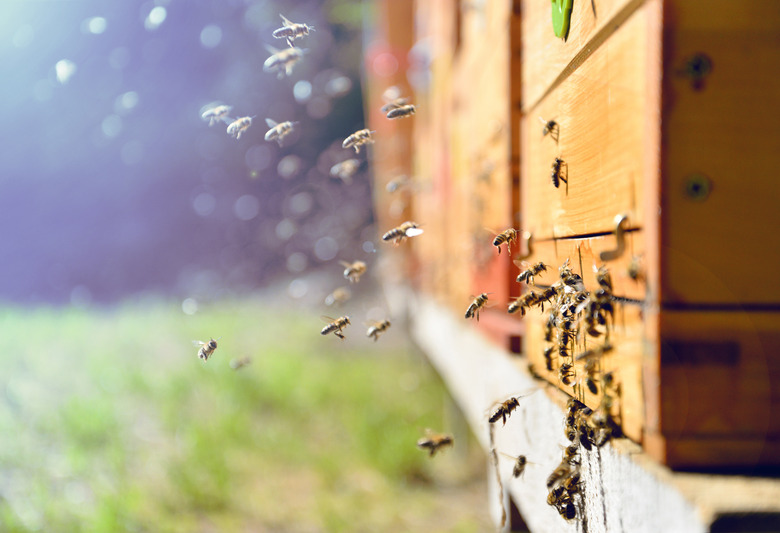Flying Insects That Burrow In The Ground
While walking through your yard or gardening, you may notice flying insects go into the ground. It's also possible you've seen mounds of soil around holes in the earth. Several kinds of flying insects make their homes in soil. These include many species in the order Hymenoptera, which includes bees, wasps and ants.
Solitary Bees
Many species of bees, wasps and hornets are social, which means they have complex family structures and the families live together. Other species are solitary and live singly on their own.
Digger bees, also called mining bees, are solitary insects that create small burrows in soil. In many cases, several queen digger bees will dig their burrows close together. Digger bees are important pollinators. They pollinate as they collect pollen and nectar for their young.
- While walking through your yard or gardening, you may notice flying insects go into the ground.
- Many species of bees, wasps and hornets are social, which means they have complex family structures and the families live together.
Digger bees tend to be honeybee-size or much smaller and vary greatly in appearance. Some species have stripes and others are metallic green. You may be alarmed at the sight of numerous digger bees hovering around a small area, but their presence is not a cause for fright. Many digger bees cannot sting and others rarely do so.
Cicada Killer Wasps
A cicada killer wasp can grow more than 1 1/2 inches long and has a black abdomen with yellow, orangish or reddish bands and markings. The female digs burrows up to 4 feet deep with numerous branching terminals. This wasp usually burrows in loose soil, including play sand and tilled vegetable gardens.
- Digger bees tend to be honeybee-size or much smaller and vary greatly in appearance.
- A cicada killer wasp can grow more than 1 1/2 inches long and has a black abdomen with yellow, orangish or reddish bands and markings.
As its common name suggests, the cicada killer exclusively hunts cicadas. The female paralyzes a cicada and stuffs it into an underground brooding cell to feed a young cicada killer in the larval stage of development.
Like digger bees, cicada killers are solitary insects but may build their nests in very close proximity to one another. The males cannot sting but may hover near anything that gets close to their area. The females, on the other hand, have large stingers, although they are not aggressive and do not actively guard their nests like many other Hymenoptera species.
Scoliid Wasps
Scoliid wasps prey upon the white grubs that damage lawns and roots. Like other solitary wasps, female scoliids paralyze their prey to feed to their larvae underground. Scoliid wasps have thick bodies that are black with white, red and/or yellow. They range from under 1/2 to almost 1-1/2 inches long.
- As its common name suggests, the cicada killer exclusively hunts cicadas.
- Like digger bees, cicada killers are solitary insects but may build their nests in very close proximity to one another.
Spider Wasps
Spider wasps is the name of a broad group of insects that includes several narrow-waisted wasp species. Most grow about 1/2 inch long and have long, thin legs. Many spider wasps are dark, either black or blue. You may encounter them as they hunt along the ground for spiders. Like other solitary wasps, spider wasps are non-aggressive and rarely sting, unless handled roughly.
Many female spider wasps build burrows in the ground. However, mud daubers also belong to the spider wasp group. They build cylindrical mud nests on vertical surfaces.
- Spider wasps is the name of a broad group of insects that includes several narrow-waisted wasp species.
Yellowjackets
Yellowjackets are social wasps that often build their nests underground in old rodent burrows or hollow wood. Yellowjackets are much more aggressive than other ground-dwelling wasps and readily attack when threatened.
These stocky wasps have distinctive yellow and black bodies. Sterile females, which are those people most often encounter, grow about 1/2 inch long. They often buzz around trashcans, picnics and barbecues looking for sources of food, including meat. Yellowjackets are beneficial due to their diet of pest arthropods such as earwigs.
If yellowjackets are not in an area with heavy human traffic, then leaving them alone is the best practice. If controlling them is warranted, find the location of their nest during the day. Return at night wearing protective clothing, including rubber gloves and goggles. Apply a liberal amount of a product containing five percent carbaryl dust into the opening of the nest.
- Yellowjackets are social wasps that often build their nests underground in old rodent burrows or hollow wood.
- If yellowjackets are not in an area with heavy human traffic, then leaving them alone is the best practice.
Ants and Termites
Although you may not think of ants and termites as flying insects, the sexually mature adults have wings and swarm. Some species colonize in the ground. You may notice swarms of them flying about and going into and coming out of the ground while seeking nesting sites.
Flying ants and termites may look similar. Both have long, clear, membranous wings that exceed the length of their bodies. An adult termite's wings, however, are much longer than its body. A termite's body is roughly the same width throughout, but an ant's body has a narrow waist between its midsection and abdomen.
- Although you may not think of ants and termites as flying insects, the sexually mature adults have wings and swarm.
- An adult termite's wings, however, are much longer than its body.
